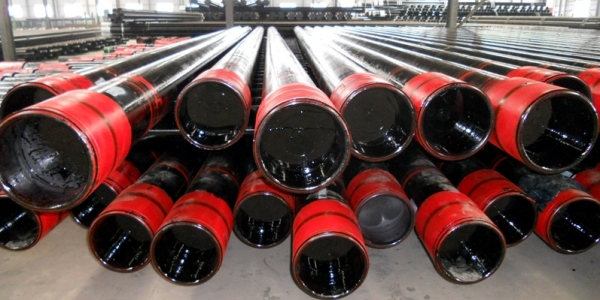La carcasa de aceite es una tubería que generalmente tiene un diámetro mayor y se utiliza para revestir el orificio. Las operaciones de revestimiento ocurren periódicamente durante todo el proceso de perforación, comenzando con el revestimiento de superficie, el revestimiento intermedio y terminando con la sarta de producción que tiene lugar durante la finalización del pozo. Hoy, en este artículo se presentarán en detalle las cuatro propiedades principales de la carcasa de aceite.

(1) Rendimiento antiinterferencias
De acuerdo con los requisitos estándar, las juntas roscadas de la carcasa de aceite deben someterse a pruebas de abrochado y aflojado. Se estipula que cada articulación debe subirse y bajarse 6 veces. Apretar al par máximo recomendado por el fabricante, luego aflojar y verificar la adherencia de las roscas internas y externas de la carcasa de aceite. La adhesión y el apriete de las roscas de aceite y carcasa están relacionados con factores como la calidad de la rosca, la dureza de la superficie de la rosca, la velocidad de apriete, el coeficiente de fricción de la superficie y la tensión de contacto (par de acoplamiento). Para mejorar el rendimiento antiadherente de las roscas de la carcasa de aceite, se debe mejorar la suavidad de las roscas y la dureza y uniformidad de las roscas, se debe reducir la velocidad de pandeo y se debe controlar el par de apriete. Al mismo tiempo, la superficie de las roscas internas del acoplamiento debe recubrirse con una película metálica blanda o no metálica para separar el cuerpo de la carcasa de aceite del acoplamiento, evitar que las superficies metálicas entre las dos roscas se adhieran y evitar que las roscas se desprendan. ser destrozado o incluso destrozado. Antes de apretar el acoplamiento, se debe aplicar grasa para roscas a la superficie de la rosca para evitar que las roscas se adhieran después de apretar el acoplamiento y mejorar el rendimiento de sellado de las roscas.
There are many coating methods for the coupling thread surface: such as galvanizing process, phosphating process, etc.; for some special materials and special connecting threads, copper plating is often required. Gluing factors related to the factory: thread parameters (pitch, thread height, taper, tightening torque, thread half angle, etc.), internal and external thread fit (surface treatment, surface finish, phosphating, galvanizing, copper plating, etc.). ), thread grease (function: lubrication, filling and sealing, etc., composed of metal powder and grease), hook-up control (lock-up torque, hook-up speed, etc.), material factors, etc.
Factors related to oilfield operations: no wire protection during hoisting, partial buckling (the pipe swings in the air and the well buckles are not concentric), no or few buckles, thread grease (not meeting standard requirements, sand and debris), tightening speed, Tightening torque, clamp clamping force, etc.
(2) Collapse (pressure) resistance
As the drilling depth increases, the pressure on the oil and casing in oil and gas wells also increases, especially in deep wells, ultra-deep wells, or formations that need to isolate plastic flow (such as rock salt, salt gypsum, shale, etc.) and soft rock formations. ), etc., are more obvious in oil and gas wells with complex formations. When the external pressure endured exceeds a certain limit, the oil well pipe body will undergo groove-like or elliptical deformation, which is called oil well pipe collapse.
(3) Corrosion resistance
Some oil and gas fields contain a large amount of corrosive media such as hydrogen sulfide, carbon dioxide or chloride ions. The corrosion resistance requirements for oil and casing include resistance to sulfide stress corrosion, CO2 and Cl- corrosion, etc. The performance of oil casing is mainly related to factors such as the chemical composition of the steel and the residual stress value of the steel pipe. Reducing the content of non-metallic inclusions and harmful elements in steel, increasing Cr, Ni and other corrosion-resistant elements, reducing the residual stress of steel pipes, and increasing the yield-to-strength ratio of steel pipes are all conducive to improving the oil corrosion resistance of casings.
(4) Perforation performance
The oil production portion of the reservoir casing (multiple layers of oil wells producing oil individually) needs to be perforated to allow crude oil to flow from the designated oil-bearing oil sand layer into the casing. For this reason, petroleum requires the casing to have good perforating performance. Especially when gun-less perforating operations are used, the requirements for the perforating performance of the casing are higher.
The perforating performance of the casing is obtained through the perforation test, that is, the tested casing is suspended in a simulated well, and a series of shaped energy perforating bombs in a certain number, a certain distance, and in different directions are suspended in the casing. Then make holes. After perforating, if there are basically no cracks around the test casing hole, the perforation performance is evaluated as good; if there are a few small cracks around each hole, but their number and length do not exceed the specifications specified in the technical conditions, the perforation performance is evaluated as good. If the number or length of cracks around each hole exceeds the specification, especially if the cracks between two adjacent holes are connected, the perforation performance will be judged to be unqualified.

 English
English Español
Español




 Tel : +86-0731-85648266
Tel : +86-0731-85648266 Correo electrónico :
Correo electrónico : 

 Noticia
Noticia




